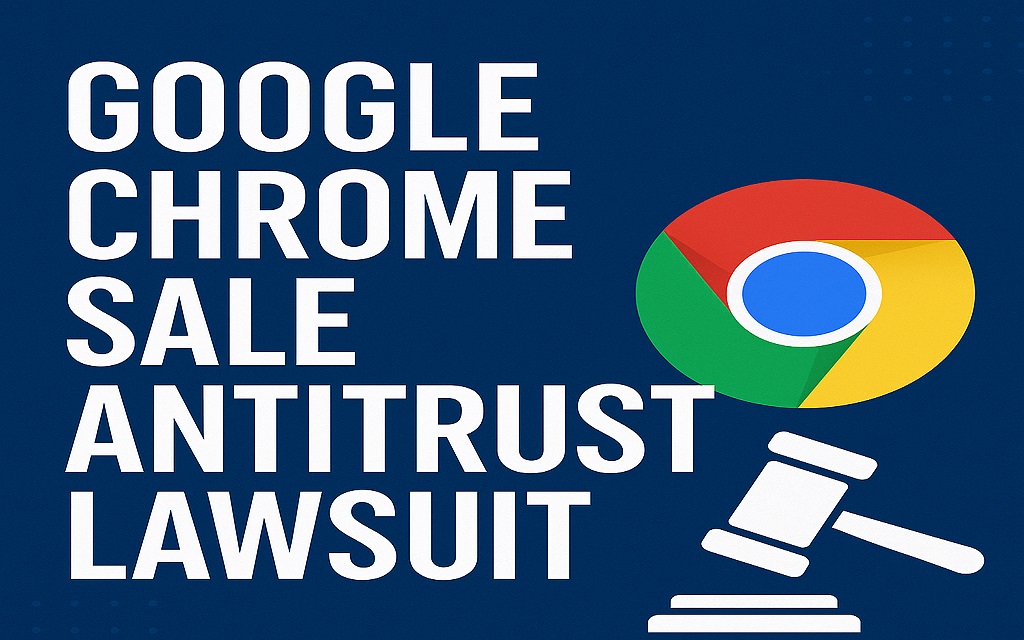With a focus on Google’s dominance in the browser industry, the DOJ has escalated its Google Chrome Sale Antitrust Lawsuit. The compelled sale of Google Chrome and the open-source Chromium project is the case’s audacious solution. This historic case may alter how consumers use the internet and how authorities address digital monopolies.
Background of the Google Chrome Sale Antitrust Lawsuit
The lawsuit is the result of a more thorough examination of Google’s purported misuse of its dominant status in digital advertising and online search. Judge Amit Mehta stated in August 2024 that Google had paid billions to ensure its search engine remained the default on browsers, phones, and other devices, thereby maintaining an unlawful monopoly in the search market. After that, the lawsuit entered the remedies phase, during which the DOJ listed possible remedial measures to stop more damage.
DOJ Proposes the Sale of Chrome

The most eye-catching solution suggested is the sale of Chrome, Google’s primary web browser, which holds a market share of more than 60% worldwide. According to the DOJ, Chrome is a crucial distribution mechanism that upholds Google Search’s hegemony. Also being examined is the open-source Chromium project, which powers Chrome and other browsers, including Microsoft Edge and Opera.
The DOJ claims that Google can manage search settings, data collecting, and user behaviour in ways that hinder fair competition by owning both Chrome and Chromium. This structure, the DOJ claims, has stifled rival search engines and reduced consumer choice.
Why Chrome and Chromium Matter in Antitrust
Chrome is more than simply a browser; it serves as the entry point for millions of users’ everyday internet usage. Chrome’s open-source foundation, Chromium, powers many browsers worldwide. The DOJ claims that Google uses Chrome and Chromium’s architecture to:
- Set default search engine agreements that discourage switching
- Collect granular user data across the web
- Push out competitors by making rival integration harder
- Reinforce its dominance across platforms, from search to AI services
By managing Chromium, Google influences industry-wide browser behavior and standards, giving it systemic influence even beyond its direct Chrome user base. This deep integration strengthens Google’s network effects.
Legal Precedents and Structural Remedy Framework
The DOJ’s proposal marks one of the boldest antitrust strategies since the 1998 Microsoft case, where structural separation was considered but ultimately not enforced. That case revolved around Microsoft’s bundling of Internet Explorer with Windows. In a similar vein, the Chrome argument centres on combining browser access with Google’s more extensive search power.
Section 2 of the Sherman Act, which prohibits the maintenance of monopolies through exclusionary behavior, is cited by legal authorities. According to the DOJ, Google’s exclusive agreements and strict control over Chromium are illegal under this law.
In contrast to financial penalties, structural remedies such as forced divestitures aim to weaken the platform’s anticompetitive architecture directly, making this trial a significant milestone in modern antitrust enforcement.
Google’s Response and Counterarguments
Google strongly opposes the proposed remedy, arguing that breaking off Chrome would:
- Compromising browser security and updates
- Erode user privacy protections due to a lack of integration
- Create fragmentation in the browser ecosystem
- Undermine innovation in Chromium-based products
In its appeal, Google called the DOJ’s remedies “radical and overbroad,” warning that divesting Chrome could disrupt the internet for billions of users worldwide. The company insists that its partnerships with device manufacturers reflect consumer demand, not coercive monopoly tactics.
The Remedies Trial: Timeline and Stakes
The remedies phase of the antitrust trial began in April 2025 and concluded in May with closing arguments. A final decision is expected by August 2025. The trial covered several key themes:
- Whether Google’s deals with Apple and Android manufacturers restricted competition
- The role of Chrome and Chromium in reinforcing Google Search dominance
- How structural remedies like divestiture could restore market fairness
- The future of search, browsers, and AI in a regulated landscape
Timeline of Key Events
| Date | Event | Description |
|---|---|---|
| October 20, 2020 | Lawsuit filed by U.S. Department of Justice (DOJ) against Google LLC and states | DOJ, joined by ten+ states, alleges Google illegally monopolises general search and search advertising markets. |
| September 12, 2023 | Trial phase begins (liability) | Bench trial starts in the U.S. District Court for the District of Columbia under Judge Amit P. Mehta. |
| August 5, 2024 | Liability decision | Judge Mehta issues opinion finding that Google unlawfully maintained its monopoly in search services. |
| April 21, 2025 | Remedies trial begins | The court holds a 15-day hearing on what remedy should be imposed to address the monopoly. |
| September 2, 2025 | Remedies ruling issued | Judge Mehta issues his ruling: No forced divestiture of Chrome or Android; but Google must share certain search index/user-interaction data and is banned from entering or maintaining certain exclusive contracts for distribution of Search, Chrome, Assistant and Gemini. |
Regulatory Precedents and Global Context
Google Chrome Sale Antitrust Lawsuit is one of the most aggressive antitrust actions since the Department of Justice’s case against Microsoft in 1998. That case led to significant operational changes without a complete company breakup. Today’s regulatory environment is more assertive, with bipartisan support for tech accountability.
Europe has already fined Google multiple times for search practices and advertising abuse. If the U.S. court orders the sale of Chrome, it could inspire similar actions globally. Antitrust enforcement may shift from fines to structural remedies that address platform power more directly.
Read Must: Case Management Software: The Smartest Way to Run Your Law Firm
Expert Commentary and Industry Reactions
Industry analysts are split. Some argue the move is necessary to curb Google’s dominance and enable open competition. Others fear unintended consequences, like weakening browser innovation or enabling bad actors to exploit a fragmented ecosystem.
Privacy advocates cautiously support the DOJ, saying a Chrome divestiture could reduce surveillance incentives. However, some cybersecurity experts worry that stripping Chrome from Google could make it more vulnerable to exploits and weaken standards enforcement.
The proposal has drawn varied reactions:
- Device Manufacturers: Google has long-standing agreements with companies like Apple and Samsung, and a divestment may change these agreements’ default search revenue structures.
- Competitors: It includes Microsoft, Brave, Mozilla, and DuckDuckGo, which have all hesitantly adopted the solution, claiming it may provide more exposure and more equitable competition.
- Advocates for privacy: Organisations such as the Electronic Frontier Foundation (EFF) believe that consumers might have more control over their data.
- Cybersecurity Experts: Some warn that removing Chrome from Google may weaken coordinated security responses and slow patch cycles.
What Happens If Chrome Is Sold?
Should the court side with the DOJ, Google may be forced to:
- Spin off Chrome into an independent company
- Relinquish control over Chromium development to a neutral foundation or consortium
- End exclusive search engine deals with OEMs
- License search index data to rivals under fair terms
This would radically shift the browser market. Competitors like DuckDuckGo, Brave, and even Microsoft Bing could see new opportunities to expand their presence. Consumers may benefit from greater transparency and choice in how their data is handled.
Future Scenarios for Chrome and Chromium
If Chrome becomes an independent product or Chromium transitions to third-party stewardship, several outcomes are possible:
- Neutral Open Web Governance: A consortium could oversee Chromium to ensure fair access and interoperability.
- Increased Browser Innovation: Competitors could leverage Chromium without fear of backdoor advantages for Google.
- More Diverse Default Settings: OEMs may offer more search engine choices, spurring innovation in privacy and performance.
These changes could ripple across the tech industry, influencing how platforms structure their ecosystems and how regulators define monopoly power.
Implications for AI and Data Ecosystems
The DOJ’s remedy proposals also extend to Google’s broader ecosystem, including AI platforms like Gemini. Regulators argue that Google’s grip on Chrome feeds data into its machine learning systems, giving it an edge in AI-driven services such as personalized search and voice assistants.
A Chrome divestiture could reduce the data inflow into Google’s AI products, thereby leveling the competitive playing field. This links the browser monopoly to broader issues of AI governance and digital dominance.
International Antitrust Momentum
Europe has already fined Google multiple times for search practices and advertising abuse. If the U.S. court orders the sale of Chrome, it could inspire:
- The European Commission to revisit prior settlements
- UK’s CMA and Australia’s ACCC to adopt structural measures
- India and Brazil to intensify scrutiny of platform gatekeeping
Global coordination may emerge, encouraging a standardized approach to tech antitrust remedies.
Conclusion: A Pivotal Moment for Tech Regulation
The Google Chrome Sale Antitrust Lawsuit seeking the sale of Google Chrome is more than a legal drama—it’s a test of how governments will regulate Big Tech in the era of AI. A forced divestiture could mark a turning point in digital platform accountability, reshaping how browsers, search engines, and AI systems coexist.
Whether the court enforces this remedy or not, the case has already changed the conversation. It signals that structural remedies are no longer off-limits and that browser power is a front line in the fight for digital competition.
Disclaimer: This article provides a general overview of the Google Chrome Sale Antitrust Lawsuit, based on publicly available information, and is intended for informational purposes only. It is not legal advice. It does not constitute legal advice.




